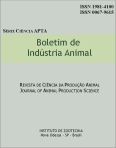Collection activity of africanized bees, Apis mellifera L. in fertile and citoplasmatic male-sterile lines of cauliflower (Brassica oleracea L.) and its influence on seed production
Keywords:
africanized honey bees, foraging behaviour, pollination, apis melliferaAbstract
Differences between cauliflower fertile and male-sterile plants and their influence on the foraging behavior for seed yield were studied Fertile plants were more attractive to bees showing bigger and perfect flowers, larger number of functional nectaries (P <0,05)) and different ultraviolet reflectance properties, allowing a more efficient pollination behaviour (corolla collection) with a consequent larger seed yield. Fertile plants were not different from male-sterile as for plants height, flowering period and flowers odour (laboratory test) (P> 0.05). The geraniol pulverization on fertile and male-sterile plants enhanced the average number of visiting bees per plant, suggesting the attainment of a more efficient pollination.Downloads
Downloads
Published
Issue
Section
License
Os autores não serão remunerados pela publicação de trabalhos, pois devem abrir mão de seus direitos autorais em favor deste periódico. Por outro lado, os autores ficam autorizados a publicar seus artigos, simultaneamente, em repositórios da instituição de sua origem, desde que citada a fonte da publicação original seja Boletim de Indústria Animal. A revista se reserva o direito de efetuar, nos originais, alterações de ordem normativa, ortográfica e gramatical, com vistas a manter o padrão culto da língua e a credibilidade do veículo. Respeitará, no entanto, o estilo de escrever dos autores. Alterações, correções ou sugestões de ordem conceitual serão encaminhadas aos autores, quando necessário. Nesses casos, os artigos, depois de adequados, deverão ser submetidos a nova apreciação. As opiniões emitidas pelos autores dos artigos são de sua exclusiva responsabilidade. Todo o conteúdo deste periódico, exceto onde está identificado, está licenciado sob a Licença Creative Commons Attribution (CC-BY-NC). A condição BY implica que os licenciados podem copiar, distribuir, exibir e executar a obra e fazer trabalhos derivados com base em que só se dão o autor ou licenciante os créditos na forma especificada por estes. A cláusula NC significa que os licenciados podem copiar, distribuir, exibir e executar a obra e fazer trabalhos derivados com base apenas para fins não comerciais.













